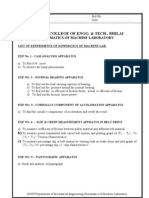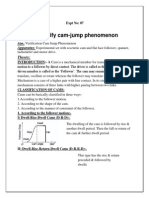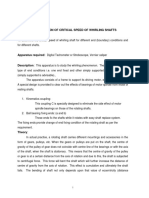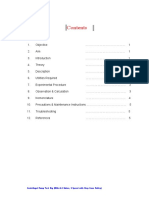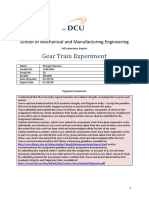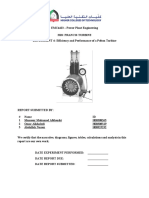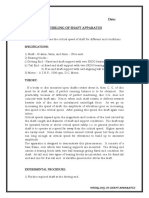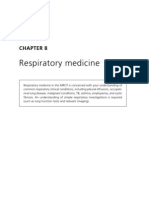Experiment:04 Cam Jump Analysis: Kinematics and Dynamics Lab Manual (ME406ES)
Experiment:04 Cam Jump Analysis: Kinematics and Dynamics Lab Manual (ME406ES)
Uploaded by
Akshay PolasCopyright:
Available Formats
Experiment:04 Cam Jump Analysis: Kinematics and Dynamics Lab Manual (ME406ES)
Experiment:04 Cam Jump Analysis: Kinematics and Dynamics Lab Manual (ME406ES)
Uploaded by
Akshay PolasOriginal Title
Copyright
Available Formats
Share this document
Did you find this document useful?
Is this content inappropriate?
Copyright:
Available Formats
Experiment:04 Cam Jump Analysis: Kinematics and Dynamics Lab Manual (ME406ES)
Experiment:04 Cam Jump Analysis: Kinematics and Dynamics Lab Manual (ME406ES)
Uploaded by
Akshay PolasCopyright:
Available Formats
Kinematics And Dynamics Lab Manual (ME406ES)
EXPERIMENT :04
CAM JUMP ANALYSIS
AIM:
1. To find out the cam and follower behavior at different
follower movement
2. To study the different types of cam and follower with their practical
uses.
3. To find out the cam follower displacement curve at different motion.
4. To find out jump phenomenon.
THEORY:
Jump Phenomenon:
The Jump phenomenon occurs in case of cam operating under
the action of compression spring load. This is transient conditions
that occur only with high speed, highly flexible cam-follower
systems. With jump the cam and the follower separate owing to
excessively unbalanced forces exceeding the spring force during the
period of negative acceleration. This is undesirable since the
fundamental function of the cam-follower system; the constraint
and control of follower motion are not maintained. Also related are
the short life of the cam flank surface, high noise, vibrations and
poor action.
Jump and Crossover Shock:
A cam-follower retained against the cam with a compression
retaining spring will under certain conditions, jump or bounce out
of contact with the cam. This condition is most likely to occur with
low values of damping and with high speed cams or quite flexible
follower trains.
Crossover shock occurs in a positive drive cam mechanism
when contact moves from one side of the cam to the other.
Clearance and backlash are taken up during the crossover, and
impact occurs. Crossover takes place on the rise or return motion
when the acceleration changes sign and when the velocity is at its
peak. The effects can be reduced by preloading the system to
remove backlash, by designing for a low peak velocity, and by using
Dept of MECH, SCCE Page | 1
Kinematics And Dynamics Lab Manual (ME406ES)
rigid follower train. Roth art states that jump will not occur in high
speed systems if at least two full cycles of vibration occur during
the positive acceleration time-interval of the motion. If a smaller
number of cycles exist during this period then, he states, the
system should be investigated mathematically to determine if jump
exists. This condition can be expressed by the equation:-
≥2
360
l = length of spring
Where Bl is the angle through which the cam rotates during positive
acceleration period. This figure can probably be reduced slightly for
appreciable amounts of damping.
Spring loses compression when jump begins and is carried in
motion with the mass. The resulting motion now gets rather
complicated because the mass, too, must be redistributed.
Probably a good first approximation could be obtained by
concentrating a portion of the mass at the bottom of spring and
treating the motion as a system of two degrees of freedom. It must
be noted, through that the system will vibrate at a new frequency
after jump begins and then analysis of the motion using the old
frequency after jump begins and that an analysis of the motion
using the old frequency is not a true description of the motion.
Spring K2 losses its compression whenever X exceeds by the
amount K2 was initially compressed during assembly. Thus to set
up a criteria for jump, it is necessary to calculate the
precompression of K2.
DESCRIPTION:
The machine is a motorized unit consisting of a cam shaft driven by a
D.C. motor. The shaft runs in a double ball bearing. At the free
end of the cam shaft a cam can be easily mounted. The follower is
properly guided in bushes and the type of the follower can be
changed to suit the cam under test. A graduated circular protractor
is fitted coaxial with the shaft and a dial gauge can be fitted to note
the follower displacement for the angle of cam rotation. A spring is
used to provide controlling force to the follower system. Weights on
the follower rod can be adjusted as per the requirements. The
arrangement of speed regulation is provided.
SPECIFICATIONS:
Dept of MECH, SCCE Page | 2
Kinematics And Dynamics Lab Manual (ME406ES)
Types of Cams
1. Elliptical cam
2. Eccentric cam
3. Snail cam
Type of Followers
1. Roller follower
2. Mushroom follower
Types Of Follower.
Followers can be divided according to the shape of that part which is
in contact with the cam.. The following diagram shows some of the
more common types:
Dept of MECH, SCCE Page | 3
Kinematics And Dynamics Lab Manual (ME406ES)
a. Knife edged.. These are not often used due to the rapid rate of
wear of the knife edge. This design
design produces a considerable side
thrust between the follower and the guide.
b. Roller Follower.. The roller follower has the advantage that the
sliding motion between cam and follower is largely replaced by a
rolling motion. Note that sliding is not entirely eliminated
eliminated since
the inertia of the roller prevents it from responding
instantaneously to the change of angular velocity required by the
varying peripheral speed of the cam. This type of follower also
produces a considerable side thrust.
c. Flat or Mushroom Follower.
Fo . These have the advantage that the
only side thrust is that due to friction between the contact
surfaces of cam and follower. The relative motion is one of sliding
but it may be possible to reduce this by off setting the axis of the
follower as shownn in the diagram. This results in the the follower
revolving under the influence of the cam.
d. Flat faced Follower.
Follower. These are really an example of the
mushroom follower and are used where space is limited. The
most obvious example being automobile engines.
Compression Springs
One spring is provided. The (approx.) stiffness is 4 Kg/cm
Weights
Dept of MECH, SCCE Page | 4
Kinematics And Dynamics Lab Manual (ME406ES)
The set of weights 200gms of 3 Nos and 100gms of 4 Nos are
provided. All the wts have a central hole so that they can be
accommodated in the push rod (Total weights provided should
add up to 1000gms).
Weights of the Reciprocating Parts
1. Push rod with lock nuts.
2. Rest plates and two lock nuts.
3. Spring seat and lock nut.
ASSEMBLY:
The unit is provided with the push rod in the two bush bearings. The
same push rod is to be used for the flat face and roller follower. The
unit is dissembled, for any reason while assembling following
precautions should be taken.
1) The horizontality of the upper and lower glands should be
checked by a spirit level.
2) The supporting pillars should be properly tightened with the lock
nuts provided.
PROCEDURE:
1. Selected a suitable cam and follower combination.
2. Fix the cam on the driving shaft by seeing the rotation of the
motor.
3. Fix the follower on push rod and properly tighten the check nut,
such that knife-edge of follower (or axis of roller in case of roller
follower) is parallel to axis of camshaft.
4. Check the upper dial to show zero without any error.
5. Rotate the cam at different angle by using handle and note down
the approximate dial gauge reading.
6. Give required initial compression to the spring. In order that initial
compression is not lost during operation, the check nut is to be
tightened against spring seat.
7. See that the knob of dimmer stat is at zero position
8. Plot the cam profile by using dial gauge reading and angle of cam
rotation.
9. Repeat the experiment by plotting different cam with different
follower.
10.Finally plot graph of follower weight and jump speed
Dept of MECH, SCCE Page | 5
Kinematics And Dynamics Lab Manual (ME406ES)
EXPERIMENTS:
Following experiments can be conducted using this machine:
1.To Plot X-O (follower displacement Vs. Angle of cam rotation)
curve for different cam follower pairs. The X-O plot can be used to
find out the velocity and acceleration of the follower system.
For this experiment rotate the system manually for taking reading,
arrange the set up. The exact profile of the cam can be obtained by
taking observations.
X Vs. O. where X – displacement of the follower from reference
initial position which is readied by dial gauge and O = angle of cam
rotation with reference from axis of symmetry chosen. By
differentiating the X-O curve once or twice, the velocity and
acceleration curves can be plotted for the follower and cam under
study. Finally switch on the motor and visual observation of
behaviour can be seen.
2. Speed:-To observe the phenomenon of jump by naked eye. When
jump occurs the follower pounds on the cam surface giving a good
thumping sound.
Upward inertia force = Downward retaining force
= +
This is the equilibrium of force equation when the jump will just
start.
W = follower weight (Assembly)
S = spring force
ω = angular velocity of cam.
r = distance according to the geometry of cam.
3. To study the effect of follower assembly weight on the jump speed
when the spring force is kept constant. To study this effect keep the
initial spring compression at a certain level and observe jump speed
for different follower weights by adding them successively and plot
the graph of follower weights Vs. Jump speed.
( + )
=
4. This relation shows that as the follower weight increases the
jump speed goes on decreases
Dept of MECH, SCCE Page | 6
Kinematics And Dynamics Lab Manual (ME406ES)
5. To study the effect of spring compression the jump speed with
constant follower weight. To study this keep the follower
assembly weight the same and go on observing the jump speed
for various sets of initial spring compression and plot the graph
of spring force Vs Jump speed.
Dept of MECH, SCCE Page | 7
Kinematics And Dynamics Lab Manual (ME406ES)
Tabular column
For Elliptical Cam with mushroom follower
Dial
Angle gaug
Dial gauge
Angle in in e
reading
degrees deg readi
s (div)
rees ngs
(div)
0 190
10 200
20 210
30 220
40 230
50 240
60 250
70 260
80 270
90 280
100 290
110 300
120 310
130 320
140 330
150 340
160 350
170 360
180
0
360
1000
350 1020
340 30
330 800 40
320 50
310 600 60
300 400 70
290 200 80
280 0 90 cam
270 100
260 110
250 120
240 130
230 140
220 150
210
200190 160
180170
Dept of MECH, SCCE Page | 8
Kinematics And Dynamics Lab Manual (ME406ES)
Snail Cam With Roller Follower:
Dial
Angle gaug
Dial gauge
Angle in in e
reading
degrees deg readi
s (div)
rees ngs
(div)
0 180
10 190
20 200
30 210
40 220
50 230
60 240
70 250
80 260
90 270
100 280
110 290
120 300
130 310
140 320
150 330
160 340
170 350
360
0
360
350800 1020
340 30
330 600 40
320 50
310 400 60
300 70
290 200 80
280 0 90 cam
270 100
260 110
250 120
240 130
230 140
220 150
210
200190 160
180170
Dept of MECH, SCCE Page | 9
Kinematics And Dynamics Lab Manual (ME406ES)
Snail Cam With Mushroom Follower
Dial
Angle gaug
Dial gauge
Angle in in e
reading
degrees deg readi
s (div)
rees ngs
(div)
0 180
10 190
20 200
30 210
40 220
50 230
60 240
70 250
80 260
90 270
100 280
110 290
120 300
130 310
140 320
150 330
160 340
170 350
180 360
0
350360
800 10 20
340 30
330 40
320 600 50
310 400 60
300 70
290 200 80
280 0 90 cam
270 100
260 110
250 120
240 130
230 140
220 150
210200 160
190 180170
Dept of MECH, SCCE Page | 10
Kinematics And Dynamics Lab Manual (ME406ES)
Eccentric Cam with Mushroom follower
Dial
Angle gaug
Dial gauge
Angle in in e
readin
degrees deg readi
gs (div)
rees ngs
(div)
0 180
10 190
20 200
30 210
40 220
50 230
60 240
70 250
80 260
90 270
100 280
110 290
120 300
130 310
140 320
150 330
160 340
170 350
180 360
0
360
3501000 10 20
340 30
330 800 40
320 50
310 600 60
300 400 70
290 200 80
280 0 90 cam
270 100
260 110
250 120
240 130
230 140
220 150
210200 160
190 180170
Dept of MECH, SCCE Page | 11
Kinematics And Dynamics Lab Manual (ME406ES)
Eccentric cam With Roller follower
Dial
Angle gaug
Dial gauge
Angle in in e
readin
degrees deg readi
gs (div)
rees ngs
(div)
0 190
10 200
20 210
30 220
40 230
50 240
60 250
70 260
80 270
90 280
100 290
110 300
120 310
130 320
140 330
150 340
160 350
170 360
180
0
360
3501000 10 20
340 30
330 800 40
320 50
310 600 60
300 400 70
290 200 80
280 0 90 cam
270 100
260 110
250 120
240 130
230 140
220 150
210200 170160
190 180
Dept of MECH, SCCE Page | 12
Kinematics And Dynamics Lab Manual (ME406ES)
Elliptical cam with Roller follower
Dial
Angle gaug
Dial gauge
Angle in in e
reading
degrees deg readi
s (div)
rees ngs
(div)
0 190
10 200
20 210
30 220
40 230
50 240
60 250
70 260
80 270
90 280
100 290
110 300
120 310
130 320
140 330
150 340
160 350
170 360
0
360
3501000 10 20
340 30
330 800 40
320 50
310 600 60
300 400 70
290 200 80
280 0 90 cam
270 100
260 110
250 120
240 130
230 140
220 150
210200 170160
190 180
Dept of MECH, SCCE Page | 13
Kinematics And Dynamics Lab Manual (ME406ES)
Do’s
1.Check the type of cam & follower
2.Set the protector at 00
3.Fit the dial gauge at the top of the follower.
4.Rotted the coupling slowly and note down the dial gauge reading.
And rotation will be 00to 3600
5.Plot the N-θ curve.
6.To attach the dimmer state to running the cam motor.
7.observe the jump speed of the follower.
8.Run the cam motor with constant speed by dimmer state to
regulate the damping sound.
Don’ts
9.Do not handle the machine without proper precaution.
10.Do not run the cam motor with high speed.
Precautions:
While assembling following precautions should be taken.
a. The horizontally of the upper and lower glans should be checked
Dept of MECH, SCCE Page | 14
Kinematics And Dynamics Lab Manual (ME406ES)
by a spirit level.
b. The supporting pillars should be properly tightened with the lock
nuts provided.
c. Lubrication It is imperative, that to minimize the sliding forces at
the bearing surfaces, lubrication is a must. Before starting,
continuous supply of oil should beprovided. The cam is to be
lubricated by oil before starting.
VIVA QUESTIONS:
1.Types of Cams
2.Types Of Follower.
RESULT:
1. The exact cam profile of the cam can be obtained by taking observation θ
(cam.rotation)(followerdisplacement) .
Dept of MECH, SCCE Page | 15
You might also like
- SAP MDG ConsolidationDocument82 pagesSAP MDG ConsolidationpoojakpitNo ratings yet
- Dynamics Lab ManualDocument51 pagesDynamics Lab ManualRavindiran ChinnasamyNo ratings yet
- Moment of Inertia of FlywheelDocument18 pagesMoment of Inertia of Flywheelgaurav singhNo ratings yet
- Flywheel ExperimentDocument7 pagesFlywheel ExperimentNabil IbrahimNo ratings yet
- Project - Art With ConicsDocument2 pagesProject - Art With ConicsFaith CarterNo ratings yet
- Bigas ProposalDocument4 pagesBigas ProposalFang Zhi100% (3)
- Case Study: Yakkatech Pty LTD: Page - 1Document8 pagesCase Study: Yakkatech Pty LTD: Page - 1Suraj ShroffNo ratings yet
- Cam Analysis ApparatusDocument7 pagesCam Analysis ApparatusGurmeet Mehma100% (6)
- Kinematics of Machine Lab ManualDocument29 pagesKinematics of Machine Lab ManualNottaAmandeepSingh100% (1)
- Cam Analysis ManualDocument4 pagesCam Analysis ManualNishant B MayekarNo ratings yet
- Applied Mechanics Lab ManualDocument80 pagesApplied Mechanics Lab Manualbasakranjan50% (2)
- Cam and FollowerDocument12 pagesCam and Followerkulkajinkya100% (2)
- Cam and Follower: Omar Ahmad Ali Ayman Mohammad Alkhwiter Eid Sunhat AlharbiDocument17 pagesCam and Follower: Omar Ahmad Ali Ayman Mohammad Alkhwiter Eid Sunhat AlharbiOmar AhmedNo ratings yet
- ME 31701 GyroscopeDocument6 pagesME 31701 GyroscopeHemanth Kumar ANo ratings yet
- Cam AnalysisDocument2 pagesCam AnalysisGaurav KumarNo ratings yet
- Experment On Watt and Porter GovernorDocument7 pagesExperment On Watt and Porter GovernorAgare TubeNo ratings yet
- Experiment #1: Whirling of ShaftsDocument7 pagesExperiment #1: Whirling of ShaftsJibran Ansari0% (1)
- Epicyclic Gear Train ApparatusDocument8 pagesEpicyclic Gear Train ApparatusGurmeet Mehma83% (6)
- Coriolli's Component of Acceleration ApparatusDocument7 pagesCoriolli's Component of Acceleration Apparatustinkusk24No ratings yet
- Experiment 6 Motorized Gyroscope: AIM: To Study The Gyroscopic Principle and Verify The Relation Between The AppliedDocument3 pagesExperiment 6 Motorized Gyroscope: AIM: To Study The Gyroscopic Principle and Verify The Relation Between The AppliedDr Praveen Kumar100% (1)
- Exp-9 Whrling of SpeedDocument6 pagesExp-9 Whrling of SpeedAKSHAT TIWARI 17BME0300No ratings yet
- Porter Governor MechanismDocument16 pagesPorter Governor MechanismShahir Afif Islam50% (2)
- Manual of Four Cylinder Four Stroke Petrol Engine Test RigDocument16 pagesManual of Four Cylinder Four Stroke Petrol Engine Test RigDhruv Patel100% (1)
- Experiment No: Objective: ApparatusDocument3 pagesExperiment No: Objective: ApparatusAfzaal FiazNo ratings yet
- Cam Analysis ApparatusDocument2 pagesCam Analysis ApparatusAshish VermaNo ratings yet
- Centrifugal Pump Test Rig (With A.C Motor, 3 Speed With Step Cone Pulley)Document9 pagesCentrifugal Pump Test Rig (With A.C Motor, 3 Speed With Step Cone Pulley)Sandeep SainiNo ratings yet
- Lab 12 Forces in A Jib CraneDocument3 pagesLab 12 Forces in A Jib CraneWaqas Muneer KhanNo ratings yet
- Dynamics Lab Manual - ME6511Document66 pagesDynamics Lab Manual - ME6511vinothNo ratings yet
- Gear Train ExperimentDocument8 pagesGear Train ExperimentRaza MutahirNo ratings yet
- Moment of Inertia of A FlywheelDocument5 pagesMoment of Inertia of A FlywheelRajaswi BeleNo ratings yet
- Exp 5 GovernorDocument40 pagesExp 5 GovernorBikash Choudhuri100% (3)
- 1.experiment On Single Rotor SystemDocument8 pages1.experiment On Single Rotor SystemRahul Kumar DwivediNo ratings yet
- Exp 6 GyroscopeDocument25 pagesExp 6 GyroscopeBikash ChoudhuriNo ratings yet
- OBJECTIVE: To Measure The Bending Moment at A: Normal Section of A Loaded Beam and To Check Its Agreement With TheoryDocument1 pageOBJECTIVE: To Measure The Bending Moment at A: Normal Section of A Loaded Beam and To Check Its Agreement With TheoryTarique AhmedNo ratings yet
- 6.acceleration of Gear SystemDocument9 pages6.acceleration of Gear SystemMuhammed Shameem N Edavannappara50% (2)
- Vibration LabDocument38 pagesVibration Labtinkusk24No ratings yet
- Experiment # 2: 90 V-Notch WeirDocument2 pagesExperiment # 2: 90 V-Notch WeirJerome BalatbatNo ratings yet
- Journal Bearing ApparatusDocument6 pagesJournal Bearing ApparatusGurmeet Mehma71% (7)
- Shaping MachineDocument14 pagesShaping MachineMohammad Javed IqbalNo ratings yet
- TheoryDocument12 pagesTheoryAhmad FikriNo ratings yet
- Experiment No 9 Load CellDocument4 pagesExperiment No 9 Load CellSagarNo ratings yet
- DL1 - Epicyclic Gear Train & Holding Torque ManualDocument4 pagesDL1 - Epicyclic Gear Train & Holding Torque Manualer_arun76100% (1)
- Experiment No 3Document3 pagesExperiment No 3pomar026100% (1)
- Vibration Engg. LabDocument14 pagesVibration Engg. LabHardial SinghNo ratings yet
- Acceleration in Slider Crank MechanismDocument8 pagesAcceleration in Slider Crank MechanismSalah benhsNo ratings yet
- MCE 4423 Experiment 4 - Efficiency and Performance of A Pelton TurbineDocument16 pagesMCE 4423 Experiment 4 - Efficiency and Performance of A Pelton TurbineMan AlbNo ratings yet
- Experiment No: 1 Date: Whirling of Shaft ApparatusDocument3 pagesExperiment No: 1 Date: Whirling of Shaft Apparatustiyifaxa100% (1)
- To Determine Natural Frequency of Torsional Vibration in Two Rotors SystemDocument3 pagesTo Determine Natural Frequency of Torsional Vibration in Two Rotors SystemmuralidharanNo ratings yet
- Mechanics of Machinery 2 - Balancing of Rotating MassesDocument11 pagesMechanics of Machinery 2 - Balancing of Rotating MassesAhmed Zawad ShovonNo ratings yet
- Mechanical Vibration WorksheetDocument6 pagesMechanical Vibration Worksheetduraiprakash83No ratings yet
- Air Flow Rig F6Document11 pagesAir Flow Rig F6demiseNo ratings yet
- Belt Friction LabDocument9 pagesBelt Friction Labasnaliffah94No ratings yet
- Mass Moment of Inertia of FlywheelDocument8 pagesMass Moment of Inertia of Flywheelabdulaziz67% (3)
- 4 Three Phase Induction Motors 1Document37 pages4 Three Phase Induction Motors 1Terry rickyNo ratings yet
- Axel Friction Me9Document6 pagesAxel Friction Me9Noman MumtazNo ratings yet
- AIM: To Conduct Performance Test On A Single Stage Centrifugal Pump Test RigDocument4 pagesAIM: To Conduct Performance Test On A Single Stage Centrifugal Pump Test RigmuralidharanNo ratings yet
- Mechanism Lab ReportDocument26 pagesMechanism Lab Reporta.rahman.kamran.2002No ratings yet
- Mom Lab ManualDocument77 pagesMom Lab ManualHammad SubhaniNo ratings yet
- Sigma ComparatorDocument4 pagesSigma ComparatorJonathan SequeiraNo ratings yet
- 174 Gyroscopic Effect On Naval ShipsDocument4 pages174 Gyroscopic Effect On Naval ShipsAniket SankpalNo ratings yet
- IC EngineDocument20 pagesIC Enginemebratu Assefa100% (1)
- Lab Manual ME 2409Document135 pagesLab Manual ME 2409Mohit lilhoreNo ratings yet
- Cam Jump Phenomenon-1Document10 pagesCam Jump Phenomenon-1Dhairyasheel Bhutkar100% (1)
- CamesDocument22 pagesCamesعبدالله عمرNo ratings yet
- Math - Unit 7Document36 pagesMath - Unit 7api-522192298No ratings yet
- Operations Management Chapter 7Document51 pagesOperations Management Chapter 7Jerome 高自立 KoNo ratings yet
- Vascular Dementia (Case Study)Document22 pagesVascular Dementia (Case Study)Coleen Mae CamaristaNo ratings yet
- Yuki Diens CV-2Document2 pagesYuki Diens CV-2Yuki Diens SeptianandaNo ratings yet
- SSG Ng01017365 Gen Cs 6180 00001 c01 River Dredging ProcedureDocument12 pagesSSG Ng01017365 Gen Cs 6180 00001 c01 River Dredging ProcedureDaniel DamboNo ratings yet
- Radiotherapy NursingDocument35 pagesRadiotherapy NursingMarlon Rey AnacletoNo ratings yet
- IMD - Wk1 - Theories and Foundations of Instructional DesignDocument8 pagesIMD - Wk1 - Theories and Foundations of Instructional DesignRICHARD ALFEO ORIGINALNo ratings yet
- 788 3470 1 PBDocument11 pages788 3470 1 PBTumpal NainggolanNo ratings yet
- A Hitchhikers Guide To Oracle Report Manager in R12: Session ID#: 13976Document43 pagesA Hitchhikers Guide To Oracle Report Manager in R12: Session ID#: 13976upmuthukumarmcomNo ratings yet
- MRCP 2Document26 pagesMRCP 2riyaz414No ratings yet
- UB Internship Report UpdateDocument55 pagesUB Internship Report UpdatepaulaNo ratings yet
- School Form 2 - SEPTEMBERDocument3 pagesSchool Form 2 - SEPTEMBERChrisma EderNo ratings yet
- Sayers 2010Document12 pagesSayers 2010壮No ratings yet
- 14 Essential Things To Know Before You Visit BolognaDocument11 pages14 Essential Things To Know Before You Visit BolognaItay AharoniNo ratings yet
- HSAB PricipleDocument5 pagesHSAB Priciplenegow57669No ratings yet
- Research MethodsDocument2 pagesResearch Methodsjmkaye TumanengNo ratings yet
- 20230123-20230124-Sandeep Kumar Sahu-Njp-Rnc TicketDocument1 page20230123-20230124-Sandeep Kumar Sahu-Njp-Rnc TicketSandy SandyNo ratings yet
- The Bodyof Lightand Magick LampDocument32 pagesThe Bodyof Lightand Magick LampAlexGLeon67% (3)
- Disciplinary Literacy ToolkitDocument9 pagesDisciplinary Literacy Toolkitapi-351389336100% (1)
- Neha Pathak Resume (2) 234Document1 pageNeha Pathak Resume (2) 234Adarsh SinghNo ratings yet
- Wood BanduraDocument26 pagesWood Banduranorhisham shamsudinNo ratings yet
- WCSA - Mapping Systemic KnowledgeDocument349 pagesWCSA - Mapping Systemic KnowledgeAndré FolloniNo ratings yet
- Rags To RichesDocument139 pagesRags To RichesjskluwangNo ratings yet
- Stats Prob QPDocument33 pagesStats Prob QPAnsh Vanpariya100% (1)
- The Brussels School of RhetoricDocument28 pagesThe Brussels School of Rhetorictomdamatta28100% (1)
- Management EssentialDocument11 pagesManagement EssentialGovind BishtNo ratings yet








